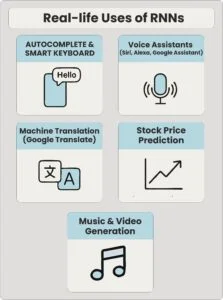Have you ever assumed or predicted the upcoming words in a sentence? You don’t consider the current word; you will recall the words preceding it. That is how our brain works with sequences. Recurrent neural networks (RNN) do the same in AI. They are built to handle data where order matters, like speech, text, or stock prices over time. Let’s understand how RNNs work, why they are so useful, and how they are used in real life.
What are Recurrent Neural Networks (RNNs)?
RNNs are a special kind of neural network designed for sequential data. Unlike regular neural networks that treat each input independently, RNNs have a memory. They keep track of previous inputs while processing new ones.
Think of it like reading a book:
- A typical neural network reads a word and then forgets the previous one.
- An RNN reads a word, remembers the context, and uses it to interpret the next word.
This makes RNNs perfect for tasks like:
- Speech Recognition (e.g., Siri or Alexa)
- Text prediction (like your phone’s keyboard)
- Stock market forecasting
- Language Translation
How do Recurrent Neural Networks Remember Things?
RNNs lie in their loops. Let us understand it in a simple way:
- Input comes in: Let’s say the word “Hello.”
- RNN processes it: RNN understands the word and stores some information in its memory.
- Next input arrives: Now use the word “world.”
- RNN uses past memory: It recalls “Hello” and connects it with “World” to form “Hello world.”
This loop allows RNNs to learn from sequences instead of isolated data points.
The Problem with Basic Recurrent Neural Networks (And How LSTMs & GRUs Fix It)
Early RNNs were a major flaw. They couldn’t handle long sequences. If it was a very long sentence, they would lose track of the start, like trying to recall the first word of a 1000-page book.
Scientists developed LSTMs (Long Short-Term Memory) and GRUs (Gated Recurrent Units) to rectify this. These are more intelligent forms of RNNs with more effective memory management and allow them to handle longer sequences more efficiently.
- LSTMs: Have a “memory cell” that decides what to keep or forget.
- GRUs: A simpler, faster version of LSTMs.
These upgrades made RNNs much more powerful for complex tasks.
Where Do We Use RNNs in Real Life?
Recurrent Neural Networks (and their upgraded versions) are everywhere in AI. Here are some examples:
- Autocomplete & Smart Keyboards: Have you ever noticed how your phone predicts the next word? That’s an RNN, remembering what you typed before.
- Voice Assistants (Siri, Alexa, Google Assistant): RNNs help these assistants understand spoken words in order, making conversations possible.
- Machine Translation (Google Translate): Translating sentences requires understanding the sequence of words. RNNs handle this well.
- Stock Price Prediction: Since stock prices depend on past trends, RNNs analyze historical data to forecast future prices.
- Music & Video Generation: Some AI-generated music uses RNNs to compose notes in a sequence that sounds natural.
Limitations of RNNs
While RNNs are powerful, they are not perfect:
- Slow for very long sequences: Even LSTMs struggle sometimes.
- Hard to Train: They need a lot of data and computing power.
- Not always the best for super-long dependencies: Newer models like transformers sometimes do better.
Wrapping up: Why RNNS Matter?
Recurrent neural networks changed how machines understand sequences. From speech to text to financial forecasts, they help AI remember and predict based on past data. There are new models, but RNNs (including LSTMs & GRUs) are still widely used. If you are learning AI, understanding RNNs is a must.
Want to Try RNNs by Yourself?
Many free tools (like TensorFlow & PyTorch) allow you to experiment with RNNs. Start with simple tasks like predicting the next number in a sequence and see how it works!
To learn more, explore YourTechDiet today!
FAQ
1. What is recurrent neural network (RNN) in deep learning?
Answer: RNN is a process that converts a sequential data input to a specific sequential data output.
2. How does RNN handle sequential data?
Answer: RNNs process data points sequentially. They allow data points to adapt to changes in the input over time.
3. What is RNN commonly used for?
Answer: Recurrent neural networks are a class of artificial neural networks. They are used to process sequential data, such as time series, text, and speech.
Further Reading:
5 Things to Know About Deep Learning
Deep Learning: The Next Frontier in AI


